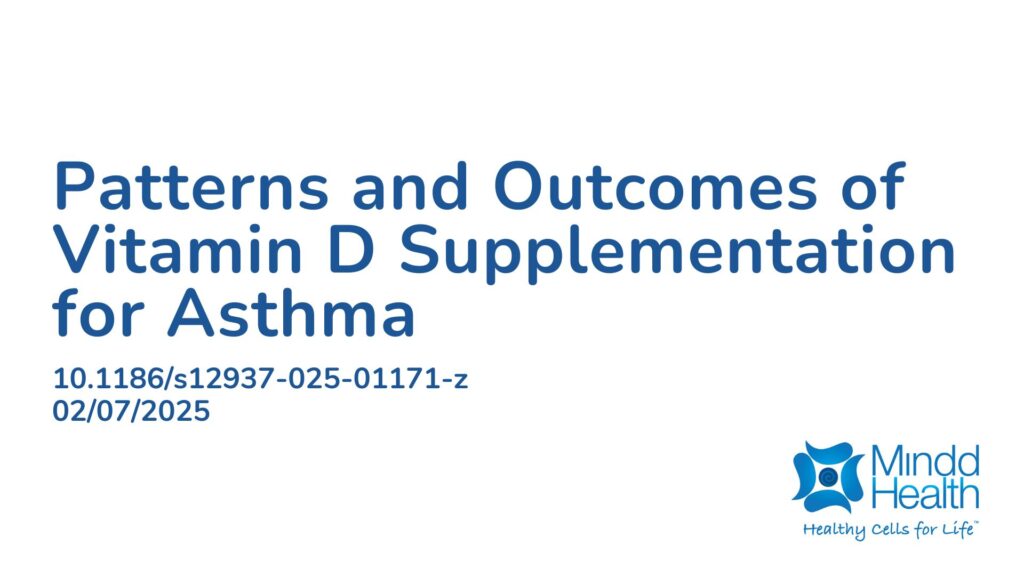Summary:
Asthma is a chronic condition that causes inflammation and narrowing of the airways, affecting an estimated 262 million people worldwide. It leads to symptoms such as wheezing, shortness of breath, and coughing, and contributes to frequent medical visits and significant economic costs. The causes of asthma are complex and include genetic factors, environmental exposures such as allergens and air pollution, and psychological factors, including stress. Vitamin D plays a role in regulating immune function and inflammation by influencing the production of cytokines and antimicrobial peptides, which are important for airway health. Some studies suggest that lower vitamin D levels are linked to higher asthma prevalence or severity, while others have reported mixed results. This study examined the relationship between vitamin D intake and asthma in adults, as well as its potential impact on mortality among adults with asthma. Results showed that higher vitamin D intake was associated with a lower risk of asthma, with the effect being more pronounced in males. Among adults with asthma, the relationship between vitamin D intake and mortality was complex. Intake below a certain threshold was linked to reduced respiratory disease mortality, whereas very high intake was associated with an increased mortality risk. Overall, the findings suggest that maintaining adequate vitamin D intake may help reduce the prevalence of asthma and improve survival outcomes. The results highlight the potential importance of vitamin D as a modifiable factor in asthma prevention and management.
Abstract:
Background: The relationship between vitamin D intake and asthma prevalence, as well as the control of asthma symptoms, remains a contentious issue in clinical settings. This study aims to clarify the relationship between vitamin D intake and asthma outcomes. Methods: In this study, three logistic regression models were employed to investigate the association between vitamin D intake and the prevalence of asthma. And a generalized additive model with a smoothing spline were utilized to explore the linear association. Additionally, subgroup analyses were conducted to assess potential effect modification by various factors. For asthmatic patients, the cox proportional hazards models were used to examine the relationship between vitamin D intake and mortality outcomes. And the restricted cubic splines were applied to assess non-linear relationships and threshold effect analyses were conducted to identify potential optimal levels of vitamin D intake that could significantly impact the risk of death from asthma. The data for this analysis were sourced from the National Health and Nutrition Examination Survey database. Results: The logistic regression analyses revealed a significant inverse association between vitamin D intake and asthma prevalence, with each unit increase in logarithmic vitamin D intake (Log VITD) associated with an 8% decrease in the risk of asthma (OR = 0.92, 95% CI: 0.86, 0.98, p = 0.02). Subgroup analyses showed a more pronounced inverse association in males (OR = 0.79, 95% CI: 0.71, 0.88, interaction p-value < 0.01). In the cohort of asthmatic patients, a non-linear relationship between vitamin D intake and all-cause mortality was identified, with inflection points at Log VITD values of 5.36 and 6.52. For respiratory disease mortality, an inflection point at Log VITD 5.48 was found, below which increasing vitamin D intake was associated with decreased respiratory disease mortality (HR = 0.01, 95% CI: 0.00, 0.05, p < 0.01), and above which it was associated with increased mortality (HR = 45.59, 95% CI: 17.61, 118.03, p < 0.01). Conclusion: This study demonstrates a inverse association between vitamin D intake and the prevalence of asthma, particularly in males. In the asthmatic population, there appears to be an optimal range of the Log VITD that may reduce mortality (ranging from 5.36 to 5.48). These findings suggest that maintaining appropriate levels of vitamin D intake may be beneficial for asthma management and potentially reduce asthma-related mortality.
Article Publication Date: 02/07/2025
DOI: 10.1186/s12937-025-01171-z



